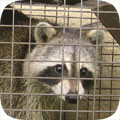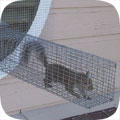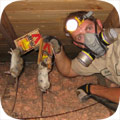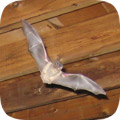- newbritain@wildlifeanimalcontrol.com
Call 24/7 for a free quote:
860-631-4258
New Britain Wildlife Animal Control
Professional Wildlife Removal Company Servicing New Britain, CT
If you have a problem with wildlife in your New Britain home, your best option is to hire a company that specializes in Connecticut wildlife removal only. This is a specialty business, and regular pest control companies do not use the proper techniques to solve animal problems. I have spent many years reviewing Connecticut and New Britain, and I recommend the following:
USA Wildlife & Exclusion
Cell Phone: 860-631-4258
NOTE: If you have a dog or cat problem, call Hartford County Animal Services: 860-826-3095

USA Wildlife & Exclusion specializes primarily in removing animals from attics of homes and buildings - this includes squirrels in attics, raccoons, and rats or mice in homes. Connecticut also has a documented problem with
bats in buildings, and USA Wildlife & Exclusion is specially trained in bat removal. They also perform general wildlife trapping services, such as the capture and removal of skunks or opossums on the
property. Call 860-631-4258 to discuss your critter problem and schedule a same-day or next-day appointment. Click here to learn more about
what prices we charge in 2022.
When hiring a company to solve your wild animal problem, you want these features:
- Specializes in wildlife removal, not pest control
- Fully Connecticut and Hartford County licensed and insured
- Works 7 days per week (critters don't take weekends off)
- Performs full building inspections: enters and inspects attic
- Performs exclusion repairs, with guarantee against animal re-entry
- Offers cleanup of biohazardous wildlife waste
USA Wildlife & Exclusion is a full-service New Britain wildlife removal company. This is very different from a regular New Britain pest control company. The pest control companies spray poison to kill insects. This is not at all
similar to wildlife removal. USA Wildlife & Exclusion performs a full inspection of the home or property, and determines why the animal(s) are there, and if inside a building, how the animals got inside. All
animals (including rodents) are trapped and removed, or if possible, removed from the building using special exclusion devices. Once the animals are gone, preventative repairs are essential, and
cleanup is sometimes recommended.
 New Britain wildlife trapping - it's not as simple as it may seem. It's illegal in Connecticut to trap without a license. Trap type is very important and there are many different types, bait is somewhat relevant, trap placement
is vital, and there are dozens of small things that are very important to know.
Safety is a concern. Then once the animal is trapped, it must be removed and dealt with in the proper manner according to Connecticut law. We offer New Britain raccoon removal. Read more about how to get rid of raccoons.
New Britain wildlife trapping - it's not as simple as it may seem. It's illegal in Connecticut to trap without a license. Trap type is very important and there are many different types, bait is somewhat relevant, trap placement
is vital, and there are dozens of small things that are very important to know.
Safety is a concern. Then once the animal is trapped, it must be removed and dealt with in the proper manner according to Connecticut law. We offer New Britain raccoon removal. Read more about how to get rid of raccoons.
 Animals in attics - this is our specialty at USA Wildlife & Exclusion. Many types of animals like to live in attics. This includes squirrels, raccoons, rats, mice, bats, birds, and even possums. Critters like to go into attics for a safe place to live
and raise their young. Removing animals from attics is very complex work, partly because of the presence of baby animals. If you need New Britain squirrel removal, we can remove all the squirrels from your attic, and seal out any future ones. Read more about how to get rid of squirrels.
Animals in attics - this is our specialty at USA Wildlife & Exclusion. Many types of animals like to live in attics. This includes squirrels, raccoons, rats, mice, bats, birds, and even possums. Critters like to go into attics for a safe place to live
and raise their young. Removing animals from attics is very complex work, partly because of the presence of baby animals. If you need New Britain squirrel removal, we can remove all the squirrels from your attic, and seal out any future ones. Read more about how to get rid of squirrels.
 Rodent control must be done in a very specific way. First off, the most important thing is that all the openings that rats and mice can use to enter a house be sealed. Then all the rodents must be physically trapped and removed.
Never, ever use poison! Most New Britain exterminators will just use this lazy poison technique to kill rodents, and it causes more harm than good - dead stinky rats, and it doesn't solve the problem. Call us for correct New Britain rat removal. Read more about how to get rid of rats.
Rodent control must be done in a very specific way. First off, the most important thing is that all the openings that rats and mice can use to enter a house be sealed. Then all the rodents must be physically trapped and removed.
Never, ever use poison! Most New Britain exterminators will just use this lazy poison technique to kill rodents, and it causes more harm than good - dead stinky rats, and it doesn't solve the problem. Call us for correct New Britain rat removal. Read more about how to get rid of rats.
 Bat removal is a highly specialized task. Connecticut is known to have colonizing bats who often live in buildings. Bats love attics. If not removed, the colony can grow to a very large size over the years. The bat droppings are often corrosive and
cause health risks. The same goes for bird droppings on or in buildings. We perform New Britain pigeon removal and bird control. But our specialty is New Britain bat removal. We remove 100% of the bat colony and seal the building so that it's totally bat-proof. Read more about how to get rid of bats.
Bat removal is a highly specialized task. Connecticut is known to have colonizing bats who often live in buildings. Bats love attics. If not removed, the colony can grow to a very large size over the years. The bat droppings are often corrosive and
cause health risks. The same goes for bird droppings on or in buildings. We perform New Britain pigeon removal and bird control. But our specialty is New Britain bat removal. We remove 100% of the bat colony and seal the building so that it's totally bat-proof. Read more about how to get rid of bats.
 If you have animals inside a house, no job is complete without proper exclusion repairs. If you simply hire a New Britain trapper who only removes the critters, then the problem will return. You need to hire a New Britain wildlife control company that identifies 100% of the animal entry points
into your building, and seals them shut with professional repairs. In addition, in many cases animals have left waste or contamination behind, and you'll want a company that can provide professional cleaning services. USA Wildlife & Exclusion does both.
If you have animals inside a house, no job is complete without proper exclusion repairs. If you simply hire a New Britain trapper who only removes the critters, then the problem will return. You need to hire a New Britain wildlife control company that identifies 100% of the animal entry points
into your building, and seals them shut with professional repairs. In addition, in many cases animals have left waste or contamination behind, and you'll want a company that can provide professional cleaning services. USA Wildlife & Exclusion does both.
The above are just some of the services offered by USA Wildlife & Exclusion. We also trap and remove animals that destroy lawns, such as moles, or digging animals. Sometimes animals like opossums will live under buildings, steal pet food, raid garbage cans, etc.
Read about how to get rid of opossums. Skunks commonly live under sheds or decks, and set up a den. We can trap and remove them without them spraying. Read about how to get rid of skunks. USA Wildlife & Exclusion
also provides dead animal removal in New Britain. If you need help with any other wildlife conflict, from a fox, beaver, groundhog, or any other critter, we can solve it. We also do New Britain snake removal - most of the snakes in Connecticut are not venomous, but
call us if you want safe removal, or read about how to get rid of snakes in New Britain. And remember, we are a private business, not Hartford County Animal Control Services, so if you have a dog or cat problem, call the County at 860-826-3095.
Hartford County animal services does not handle any wildlife issues.
USA Wildlife & Exclusion: 860-631-4258
New Britain Pricing Info For Year 2022
 Every wildlife removal situation is different, from the species of animals involved, the location of the animal inside a house or outside, the extent of repairs or cleanup, etc. It's impossible to give one-size-fits-all prices. Examples MIGHT include:
Every wildlife removal situation is different, from the species of animals involved, the location of the animal inside a house or outside, the extent of repairs or cleanup, etc. It's impossible to give one-size-fits-all prices. Examples MIGHT include:
Small Job: For example, a one-stop job to remove an animal in the yard: $100 on up
Medium Job: For example, getting critters out of your house with minor repairs: $300 on up
Large Job: For example, a project involving many service trips and complex work: $500 on up
Give us a phone call now and tell us about your wildlife issue and we will be able to give you a price estimate over the phone. If you're cool with it, we can schedule a same-day or next-day appointment if you like. Our prices are fair, and a good value because we do the job right, the first time.
New Britain Wildlife Tip #1:
How do snake eat?
All living things need to feed and snakes are no exemption. While some animals have well-defined teeth that help them to munch their food before swallowing, snakes swallow their food whole without having to chew on them.
Snakes are carnivores and maintain a strictly animal diet. In the wild, snakes employ different tactics to feed. Some snakes go hunting for preys while other lies in wait patiently until one comes passing by. The smallest snake the Thread Snake feeds on eggs or pupae of centipedes and ants while larger snakes such as anacondas and pythons can feed on animals such as pigs and deer and even humans.
Snakes do have teeth but their teeth are not meant for chewing on prey they are properly lined and spaced to hook and grab on to their prey which makes it easier to swallow. For smaller snakes, they can simply strike their victims which are mostly insects and rodents and swallow them whole without stress. But for a big snake and a much larger prey, for example, the python can attack a cock in the wide and kill it. To be able to swallow it, it would employ a tactic where it twists itself around its catch and using its heavy muscles squeeze and tighten its grip to crush its victim. This makes it easier to swallow their victims whole.
For venomous snakes like rattlesnakes, cobras, and vipers, they use an equally different tactic when hunting for prey. They strike the prey and deposit enough amount of venom in their system and wait for the effect to set in. The prey in a short time is paralyzed from the venom and the snake then swallows it whole. Snakes with venoms and those without venoms both swallow their food whole. It's difficult to comprehend how a tiny and creeping animal like the snake can swallow a large animal such as a Pig.
First of all, the jaws of a snake are strong and can extend to perfectly accommodate large preys in its mouth. Secondly, snakes have strong rib bones and muscles that constrict to crush the skeleton of their victims which helps then in suffocating their prey and also makes it easier for them to swallow whole.
Snakes use their tongues in picking up smells and odor from their environment which includes the smell of nearby preys. They are also able to detect temperature changes which help them in locating food. Feeding can take up to an hour or more depending on the size of the prey. The food is passed from the mouth to the long stomach of the snake by the help of muscles along its body which sends the food down the throat until it gets to the stomach.
Once the food gets to its stomach, depending on the size of the meal it can take months for the food to fully digest. Meals like insects and rodents can take a week or two to digest while large animals like pigs and deer can take up to six months before they are broken down completely.
New Britain Wildlife Tip #2:
Connecticut Wildlife Information:
Connecticut State bird: American robin
State mammal: Sperm whale
State fish: American shad
State insect: European mantis
Connecticut is a small state in the nation, and despite being technically on the coast of the country, it does not have an ocean border. The state is connected to the Atlantic Ocean through Long Island Sound and Block Island Sound, but has no actual sea coast of its own. The majority of the state was originally wooded, though areas of farmland have since been cleared. The forests are full of broad-leaved trees with a mixture of coniferous woodland, and there is a steady rise of terrain to the mountains in the northwest. Summers in the state are warm to hot, and winters are cold; the ocean mediates temperatures and moisture content in the atmosphere.
The state does not have a huge variety of large animals. The moose is the dominate creature on land in size, and it is the only large grazer aside from white-tailed deer. A subspecies of the white-tailed deer, called the key deer, grow to be only 3 feet tall and weigh up to 80 pounds. This subspecies is protected due to dwindling numbers. The key deer are easy targets for coyotes who roam the forested regions of the state. Black bears are also present, but the bears rarely take to hunting down large prey. Black bears spend much of their time foraging for fruits and insects, or raiding easy meal locations like birds' nests. The state has a healthy population of bobcats that keep the numbers of smaller animals manageable.
As in most states of the Northeast, Connecticut has a variety of forest-dwelling critters that hold the potential to become pest animals. Raccoons, skunks, opossums, rats, mice, bats, gophers, woodchucks, weasels, minks, and beavers are all occupants of the state. Connecticut has lemmings, small, elusive rodents that have gotten a reputation for mass suicides. These communal death marches are a misnomer; the lemming will sometimes migrate in numbers during the breeding season. Because the animals are good swimmers, they will often attempt to cross waters where a significant number of them drown. They are not throwing themselves off cliffs for no apparent reason.
Though access to the ocean is had by way of a protected region of water, Connecticut has a number of marine animals including manatees and harbor seals.
You can always call USA Wildlife & Exclusion, any time of day, at 860-631-4258, for a price quote for New Britain wildlife control services. I am confident that this is the best choice amongst wildlife removal companies in New Britain, CT.





































